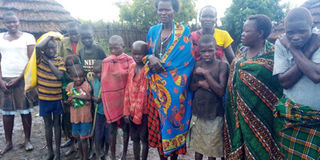350 evicted families seek compensation

Homeless. Some of the evicted families in Namalu Sub-county, Nakapiripirit District outside their shelters. PHOTO BY LEONARD MUKOOLI
What you need to know:
- Struggling. The families live in grass-thatched houses and some provide casual labour at the Prisons farm in Nakapiripirit.
- "The government first compensated the owners of the land in three phases and the last portion was bought in 1967,” Frank Baine, prisons spokesperson
Nakapiripirit. Nearly 350 households, who were evicted from about a 3,000-acre piece of land in Namalu Sub-county, Nakapiripirit District, three years ago, are demanding compensation.
The families have lived in temporary shelters since 2014 after they were allegedly evicted by Uganda Prisons Service. Prisons has since established a farm on the land.
Mr Hudson Loduku, 88, one of the affected tenants, said he had lived on the piece of land for decades but was evicted without being compensated.
“We were forcibly evicted and left homeless. We have continued to live in anguish,” Mr Loduku says.
“The government has not told us where to go because east of Namalu, we are told the land is for Uganda Prisons Service; to the west and south, we have been told it is for the Uganda Wildlife Authority,” he adds.
The affected residents currently live a few metres away from the prisons farm, where they have built grass-thatched houses.
Ms Joyce Akello, 33, another resident, says life has become difficult since the eviction.
“We have no permanent home since what used to be our home and gardens, were all destroyed. Granaries were also not spared, leaving us with nothing,” Ms Akello says.
Ms Agnes Ariang, another affected resident, says they provide labour to Prisons in order to earn a living.
Mr Simon Longoli, the coordinator of Karamoja Development Forum, an NGO, says more than 400 people have since migrated to nearby towns such as Mbale, Soroti and Kumi to engage in casual labour.
“Some have ended up offering casual labour to nearby farms while others have migrated to towns as street beggars,” Mr Longoli says.
The Nakapiripirit District Woman MP, Ms Esther Anyakun, says the manner in which Prisons acquired the land was irregular.
“Even though the government was implementing a good project to help the community, the manner of the acquisition of the land violated the rights of Ugandans,” Ms Anyakun says.
She says the government should resettle the families.
Mr Frank Tumusiime, the coordinator of Advocacy for Natural Resources, an NGO which fights for the affected locals, says the government should compensate the families for the lives lost.
“This was not only an abuse of the constitutional right to own property but it is an infringement on right to life, education, food, housing and shelter,” Mr Tumusiime says.
However, the prisons spokesperson, Mr Frank Baine, dismissed the allegation that the affected residents were evicted.
“The residents who lived on the contested land were early compensated in the early 1960s. They never owned land they claim ownership over,” he says.
Mr Baine says each of the affected residents was paid Shs1.6 million as compensation.
“The government first compensated the owners of the land in three phases and the last portion was bought in 1967,” he says.
According to Mr Baine, the documents show that the people were compensated, adding that before eviction, people were temporary staying on that land.
“We needed to expand the “Feed Karamoja children project’ that why we asked them to leave the land for the purposes of having the linear farming,” he said.
The project is an initiative by the Office of the Prime Minister in partnership with World Food Programme and Prisons aimed at providing schools in Karamoja sub-region with food.
Effect of eviction
According to a 2014 report released by Karamoja Development Forum, an NGO, titled; ‘Take anything, leave our land” observed that 75 per cent of the people (between the ages of eight and 35) left Namalu following the eviction.
The report also indicated that the evictions saw a surge in school dropouts in the area once homes were broken and families disentangled. Another report published in February 2015 revealed that 50 people, between February and December 2014 died as a result of starvation, and diseases related to the living conditions in a swamp that became their home.



